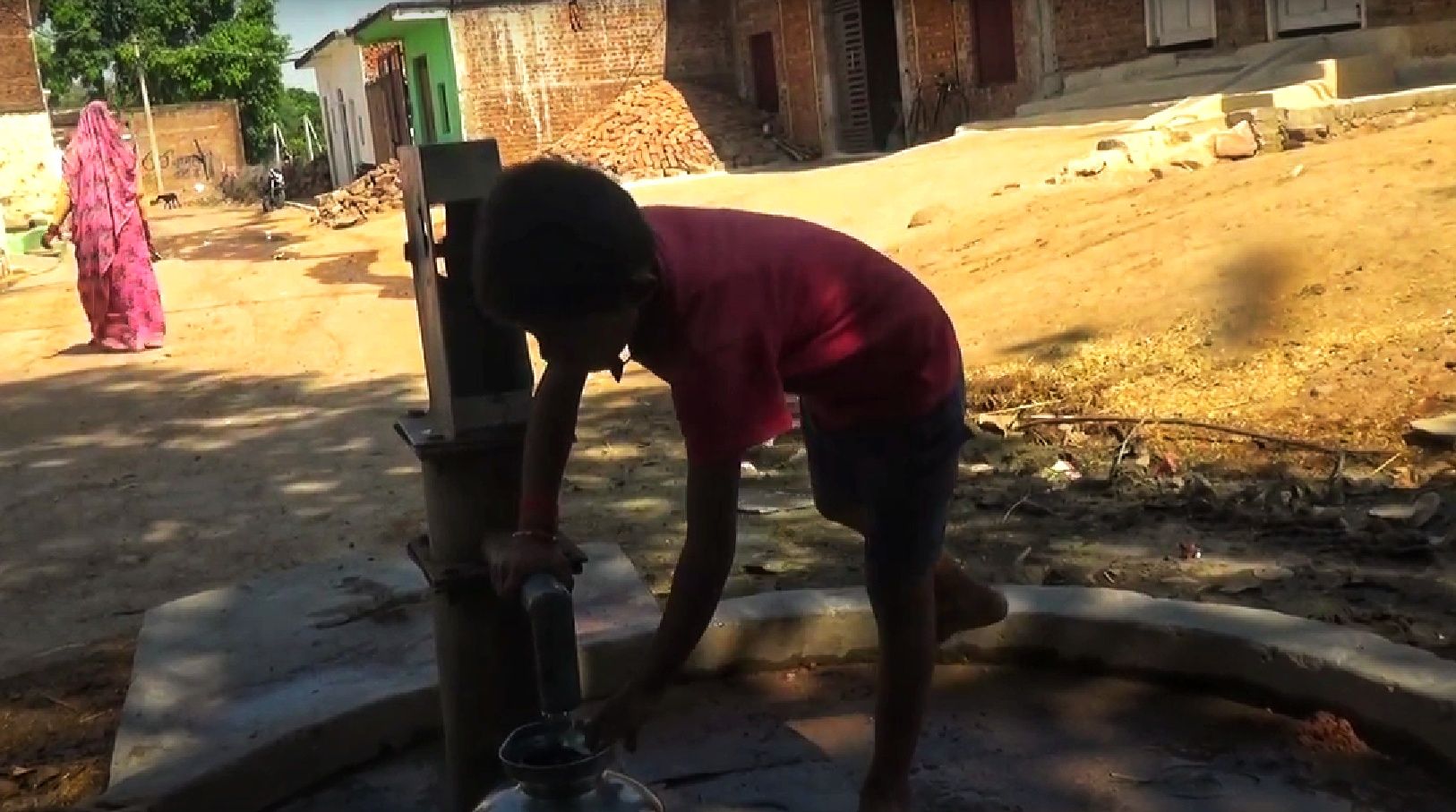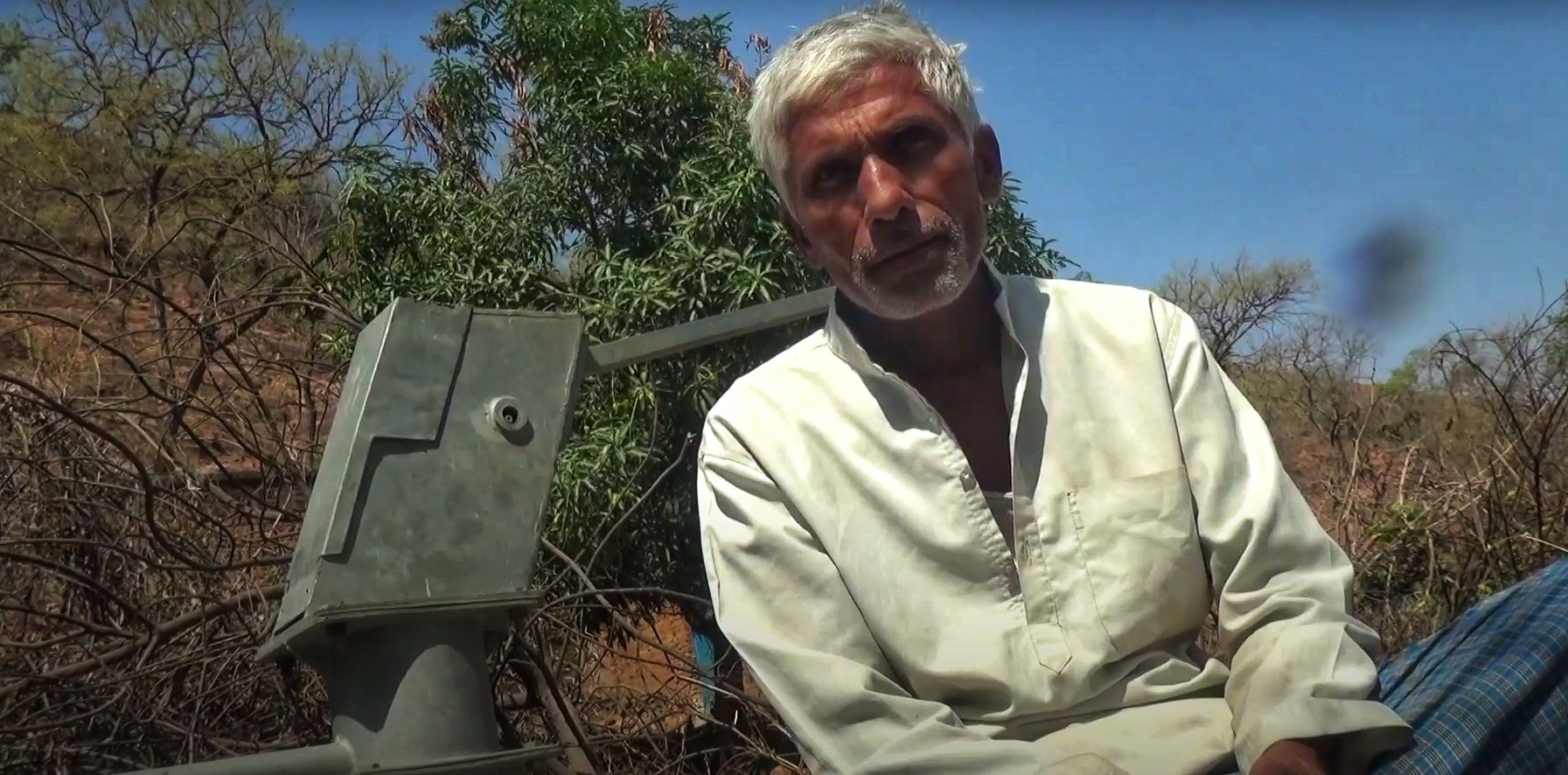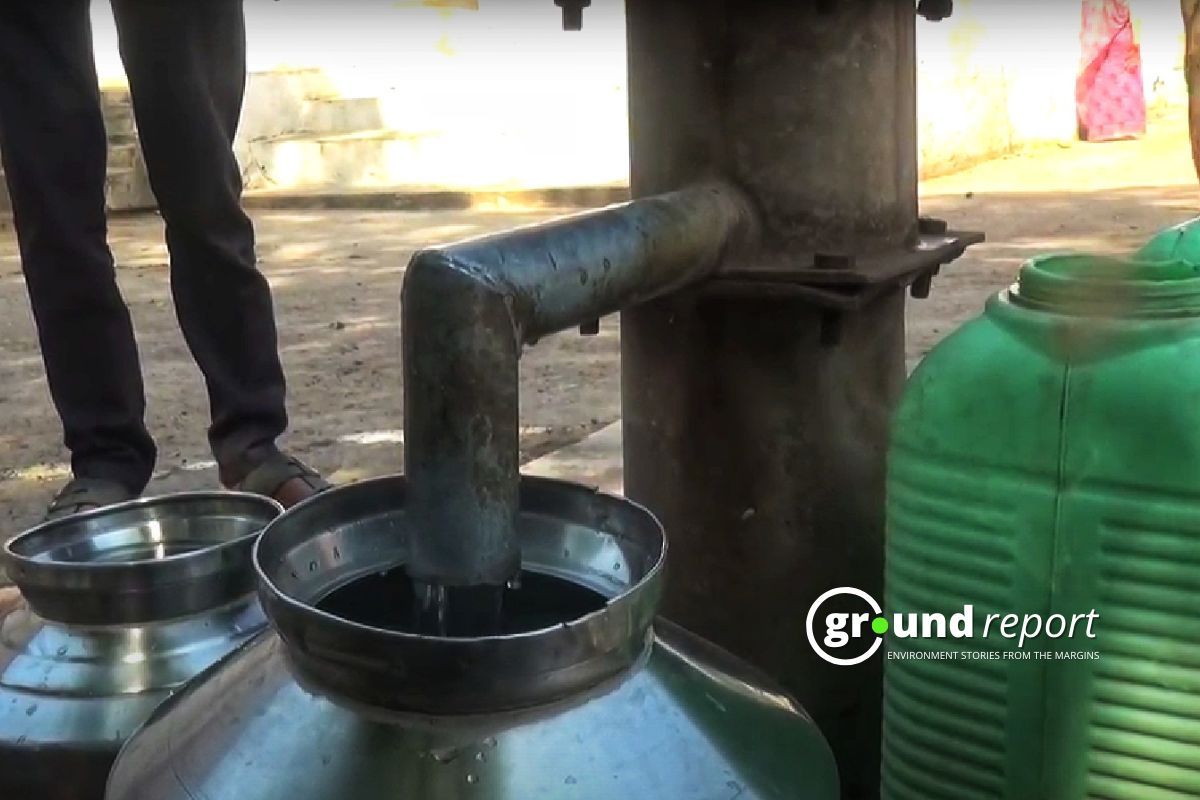The only access to Machora, a village– in the Jatara Tehsil of Tikamgarh district– situated approximately three km away from the Jatara bypass, is through an unmetalled road. As we entered the village, the villagers, mostly men, were gathered under a banyan tree, playfully discussing politics and other matters of importance. On the other hand, women and children form a line to get water from the village’s lone working hand pump.
With optimism in her eyes, Girja, while fetching water from the hand pump, discusses the generational weight that falls on women to get water.
“We are doomed with this curse, my little children also help me to carry water and whenever my son gets married, his wife will also have to do the same,” she sadly replied on being asked about her struggle for water.
Since she is the only woman in a six-member house, she believes she has to get the family water. This is her ‘duty’
“Haan, vote denge, sarkar ki madat to karenge… shayad ek din aurton ko azadi mil jaye, (I will vote and help the government…. maybe we women will get freedom one day)” said Girja, a resident of Machora.
Children as young as six to ten years of age are compelled to carry water containers over their heads to assist their mothers and ensure water is available at home.

According to the information from the municipal corporation of Tikamgarh, out of the total available hand pumps in Jatara tehsil, 115 are non-functional and 25 need repair. Due to a single functional hand pump, the women in Machora walk to get water from a well located about a kilometre away, early in the morning. The current well is also expected to dry up by June, which worries the villagers.
According to the Jal Jeevan Mission dashboard, Machora village has received 88.92% of tap water connection, but in reality, villagers say the construction of water tanks is still in progress, leaving the tap water connectivity still a far-fetched notion. Although the pipelines were laid under Har Ghar Jal Yojna, now they are mostly broken over delays in connectivity. The gap between the on-ground realities and the government data was also observed in our previous report from the Tikamgarh district of Bundelkhand.
‘Generational duty’ for women
After Girja went with her containers on her head and hands, Ganeshi was next in line. In her red saree, veil over her head, she was initially apprehensive to speak but eventually found ease. She described her hectic schedule, which includes housework, farmwork, and water fetching.
“It’s difficult to manage time, so my mother-in-law and 10-year-old daughter also come with me to fill the water, whenever I am busy at the farm,” she told Ground Report.
When asked if the men of the family also fetch water, she smiled slightly and said “It’s a woman’s job.” – reinforcing the generational trap of women’s household ‘duty’.
The rich-poor divide
A subtle slim through the kachha and pucca houses prominently displays the economic disparity in the village. While women struggle to fetch water on one side, water from a private borewell overflows just 200 metres away.
“People who can afford to get a private borewell, easily get water but they deny and sometimes abuse us if we request them for water,” told Girja to Ground Report.
An old man, named Vrindavan, another resident of the village, must be in his seventies, walked barefoot ahead of us. He took us on a walk for a kilometre to show us a hand pump that had dried up. He also expressed his concern about how water scarcity has also impacted agriculture drastically.

“I am a farmer, over the years due to lack of water we have shifted from wheat to mustard,” he informed.
In the Jatara tehsil of the district, the majority area is irrigated by canals and groundwater. However, villagers complain that the canals dry up in summer and groundwater is gradually going down. According to the ground-water yearbook (2022-23) analysis by the Central Ground Water Board, the 10-year data of May month (Between 2013-2022) out of 23 wells in Tikamgarh, 14 wells show a decrease of 61 percent in the water level. The highest stage of groundwater extraction is computed as 88.73% (81.26% in 2019- 20) for the Jatara block. In the last two decades (1997-2016), Tikamgarh district has shown growth in the Agriculture sector, resulting in pressure on groundwater utilisation. Groundwater is the only source of irrigation in 77.63 % of the area.
“Earlier, borewells were not dug as deep as they have to do now. Now, the borewells are dug up to 300-400 ft. to get the water,” Vrindavan added.
High dependence on groundwater
A report suggested that two locations namely Jatara (2.20 mg/l) and Palera(2.02mg/l) reported fluoride concentration more than the Bureau of Indian Standards (BIS) permissible limit i.e. 1.5 mg/l.
Geographically, Tikamgarh forms nearly the centre of the Bundelkhand Region that lies between the Vindhyan plateau in the south and the great Ganga-Yamuna plains in the north. Like the region in general, the district has a distinct slope toward the northeast. All blocks of the district are categorised as semi-critical in groundwater development.
According to a state of Madhya Pradesh report, the Government of Madhya Pradesh sanctioned a total budget of Rs. 314.54 crores for the Atal Bhujal Yojna to work towards preserving groundwater levels in 6 districts and over 678 gram panchayats. From the Tikamgarh district, Baldegarh and Palera blocks have benefited from the scheme, whereas Jatara block has yet to receive benefits (Page no.240). Villagers complain about negligence by the authorities who have forgotten about the basic requirements of the village.

“At the time of power cut, even the people with borewells rely on this only hand pump,” said Rajendra Singh, a resident of the village.
Despite the government’s various schemes and initiatives throughout the years, the burden on women in terms of water access remains unaltered. Like Girja and Ganeshi, many women in rural areas of the country yearn for freedom while walking miles for what has become a generational unpaid job for them. With every election, women hope for a better future for themselves while exercising their power to vote for easy access to the basic necessities. Although gradually the situation is improving, it needs some leap steps to uplift the rural women.
Keep Reading
Indian agriculture household earns just Rs. 10,218 in a month: Govt
Post-harvest losses still high, reveals data shared in Lok Sabha
Khadi Haat village’s power-free wastewater treatment solution and more
Support us to keep independent environmental journalism alive in India.
Follow Ground Report on X, Instagram and Facebook for environmental and underreported stories from the margins. Give us feedback on our email id greport2018@gmail.com.
Don’t forget to Subscribe to our weekly newsletter, Join our community on WhatsApp, and Follow our YouTube Channel for video stories.






